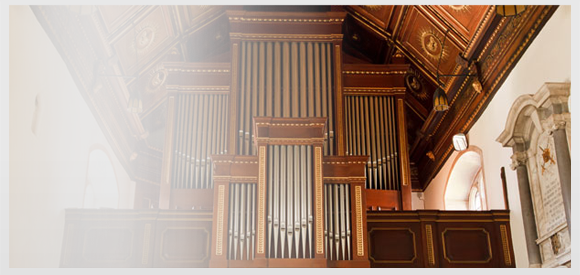University of Tennessee at Chattanooga —The Tower
The organ located on the second floor of the tower was first installed in
1880 in the Congregational Church of Keokuk, Iowa. Sometime after that it
was sold to Third Presbyterian Church in Chattanooga. Inscriptions inside
the Swell box say “Keokuk, Iowa” and “Rev. I. D. Steele, 3rd Presbyterian
Church, Chattanooga.” So, it was after Dr. Steele became pastor of Third
Church.
Third Presbyterian was founded in 1905 as a Northern Presbyterian spinoff of
First Cumberland Presbyterian Church. They first used the chapel of Old
Main, the central building at the present UTC. Then, in 1911, they erected
a a church building at the NE corner of Oak and Baldwin. The congregation
waned and, when Dr. Steele retired in 1943, the congregation voted to close.
Most of the members joined First Presbyterian Church. The university
purchased the building for use as barracks for Air Force trainees during
World War II. In later years, the church was used as the women’s gymnasium
and, for years prior to being razed, it served as the University Drama
Workshop.
The organ is listed in the Hook Opus List as a 2-18, which means it had 18
mechanical movements, not 18 stops. If you figure in two unison bass stops,
three coupler knobs, tremolo and blower signal, you arrive at 17. Perhaps
it had a wind gauge on it, which would make 18. At some time, possibly upon
the university’s purchase of the building, the organ was moved to the tower
of Patten Chapel in very close quarters on the second floor. It was used as
a practice organ well into at least the 1950’s.
Hook & Hastings, Opus 976, 1880, 2/10
GREAT
8′ Open Diapason
8′ Melodia
8′ Dulciana
4′ Octave
2′ Fifteenth
SWELL
8′ Stopped Diapason
8′ Viola tc
4′ Harmonic Flute
8′ Oboe
PEDAL
16′ Bourdon
Swell to Great 8′
Great to Pedal 8′
Swell to Pedal 8′
Tremolo
Blower Signal
Compass 58/27
SOURCES:
Information on the organ from Brad Rule, B. Rule & Co., organbuilders
Information on the church from the book “Catalyst for
Christ – 150 Years,” by David Cooper, a history of First Presbyterian church and related subjects




